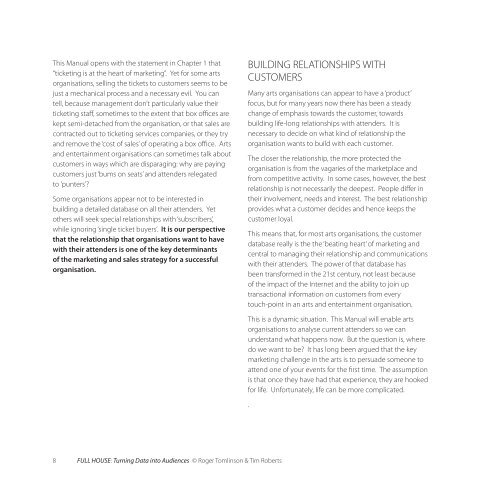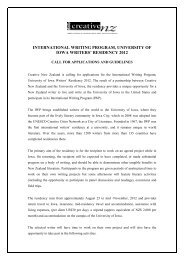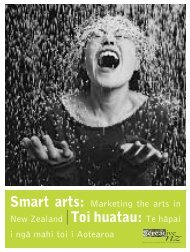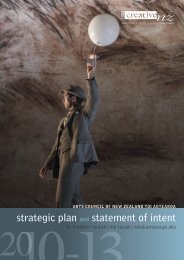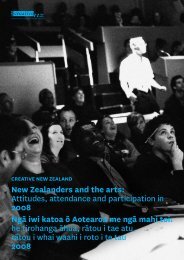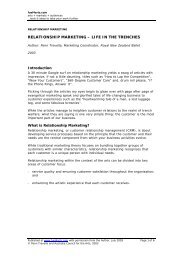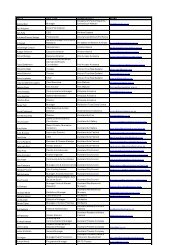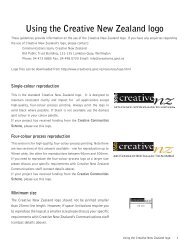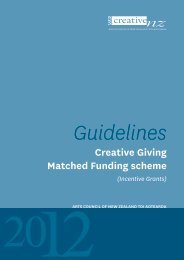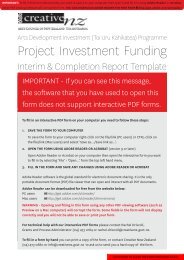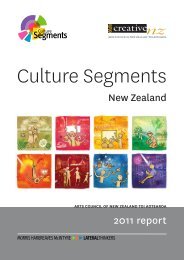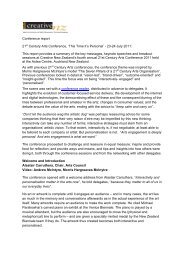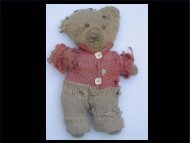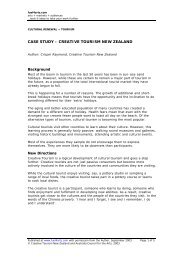FULL HOUSE Turning Data into Audiences - Creative New Zealand
FULL HOUSE Turning Data into Audiences - Creative New Zealand
FULL HOUSE Turning Data into Audiences - Creative New Zealand
Create successful ePaper yourself
Turn your PDF publications into a flip-book with our unique Google optimized e-Paper software.
This Manual opens with the statement in Chapter 1 that<br />
“ticketing is at the heart of marketing”. Yet for some arts<br />
organisations, selling the tickets to customers seems to be<br />
just a mechanical process and a necessary evil. You can<br />
tell, because management don’t particularly value their<br />
ticketing staff, sometimes to the extent that box offices are<br />
kept semi-detached from the organisation, or that sales are<br />
contracted out to ticketing services companies, or they try<br />
and remove the ‘cost of sales’ of operating a box office. Arts<br />
and entertainment organisations can sometimes talk about<br />
customers in ways which are disparaging: why are paying<br />
customers just ‘bums on seats’ and attenders relegated<br />
to ’punters’?<br />
Some organisations appear not to be interested in<br />
building a detailed database on all their attenders. Yet<br />
others will seek special relationships with ‘subscribers’,<br />
while ignoring ‘single ticket buyers’. It is our perspective<br />
that the relationship that organisations want to have<br />
with their attenders is one of the key determinants<br />
of the marketing and sales strategy for a successful<br />
organisation.<br />
BUILDING RELATIONSHIPS WITH<br />
CUSTOMERS<br />
Many arts organisations can appear to have a ‘product’<br />
focus, but for many years now there has been a steady<br />
change of emphasis towards the customer, towards<br />
building life-long relationships with attenders. It is<br />
necessary to decide on what kind of relationship the<br />
organisation wants to build with each customer.<br />
The closer the relationship, the more protected the<br />
organisation is from the vagaries of the marketplace and<br />
from competitive activity. In some cases, however, the best<br />
relationship is not necessarily the deepest. People differ in<br />
their involvement, needs and interest. The best relationship<br />
provides what a customer decides and hence keeps the<br />
customer loyal.<br />
This means that, for most arts organisations, the customer<br />
database really is the the ‘beating heart’ of marketing and<br />
central to managing their relationship and communications<br />
with their attenders. The power of that database has<br />
been transformed in the 21st century, not least because<br />
of the impact of the Internet and the ability to join up<br />
transactional information on customers from every<br />
touch-point in an arts and entertainment organisation.<br />
This is a dynamic situation. This Manual will enable arts<br />
organisations to analyse current attenders so we can<br />
understand what happens now. But the question is, where<br />
do we want to be? It has long been argued that the key<br />
marketing challenge in the arts is to persuade someone to<br />
attend one of your events for the first time. The assumption<br />
is that once they have had that experience, they are hooked<br />
for life. Unfortunately, life can be more complicated.<br />
.<br />
<br />
<strong>FULL</strong> <strong>HOUSE</strong>: <strong>Turning</strong> <strong>Data</strong> <strong>into</strong> <strong>Audiences</strong> © Roger Tomlinson & Tim Roberts


